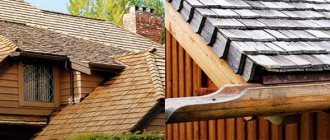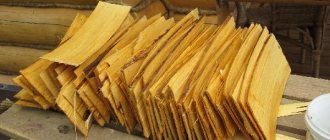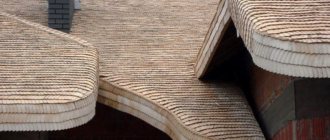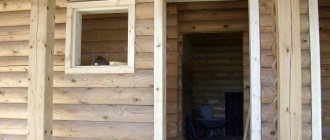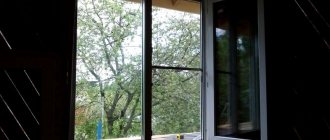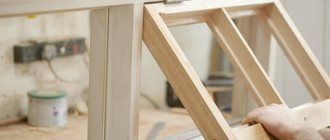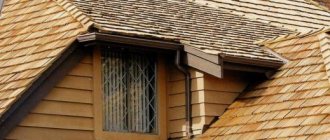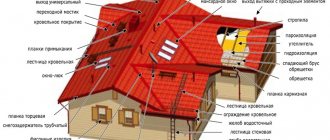The use of natural materials for roofing is one of the most popular solutions. They are able to provide the roof with a beautiful appearance that attracts the attention of everyone who sees the house. Deciding on a specific coverage option can be difficult.
Roofing shingles most often become the final choice, as they have many advantages and positive characteristics. And you can install it yourself.
Methods for making shingles
Shingles are plates made of aspen, cedar or oak, used for installing roofing and cladding facades. Do-it-yourself roofing shingles can be made from inexpensive coniferous trees, such as spruce and pine. The resin found in trees prevents the growth of bacteria and fungi because it is a good antiseptic. Also, plates made from softwood can withstand different temperatures.
Choose wood with straight trunks without knots or cracks. The diameter of the trunk may not be large, the main thing is that after cutting the length of the logs is 40-45 cm. The core of the tree must be cut out, since it is susceptible to cracking. To make the roof last longer, the bark, which is susceptible to rapid rotting, is also removed from the logs.
Then the logs are manually chopped into wedge-shaped or rectangular plates with a thickness of 3 to 8 mm and a width of 8-18 cm.
Shingles are also produced mechanically. The log is sawn into logs about 80 cm long, from which timber is made the same width as shingles, and cut into plates. It is convenient to cover large roofs with such shingles; for smaller ones, they are sawed.
Splitting timber into plates
The disadvantage of sawn shingles is their shorter service life. The fact is that wood, when cut, does not retain its fibrous structure, as happens with the split method, where the wood splits naturally. Thus, the cut affects the structure of its integrity.
To extend the life of shingles, as well as preserve its original appearance, special impregnations for wood are used.
Types of wooden roofing
In general, the concept of wooden roofing means tiles or their analogues made of wood. There are several types of material in question:
- shingles - small boards that are laid on the roof in a checkerboard pattern;
- shindel - planks of irregular shape and small size, which can be laid either in a checkerboard pattern or overlapping;
- shingles - figured sawn planks;
- ploughshare - a tile made of wood, spade-shaped, but now practically not used;
- tes are boards made of pine wood.
Most often, when equipping a roof, shingles and shingles are used - these two types of wooden roofing can not only perform protective functions at a high level, but also support the overall style of the building and fit perfectly into any landscape design.
Shingles
Manufacturers claim a service life of shingles of 50 years - this is already a long time, but look at ancient buildings that stand for more than 100 years - their roofs were made of shingles, and their appearance still remains attractive.
The shingles cope well with their “responsibilities” - they reliably protect the house from rain and wind. This happens due to the natural properties of wood - during rain, the “petals” of the shingles swell and close together, and in the warm season, on the contrary, they dry out a little and free space appears between them. In the first case, the shingles closed together do not give even a small chance of moisture penetrating into the house, and in the second, space appears for ventilation.
The main advantage of shingles is that such a wooden roof is lightweight, which does not require the installation of a powerful rafter system. Due to its light weight, shingles can also be used for houses with low foundations.
It is quite possible to make roofing shingles with your own hands - you will need wooden blocks from 40 to 100 cm long, pre-soaked in water. They are planed into chips, and the size is not important, but the thickness should be about 5 mm. As a rule, for a wooden roof of a house, shingles are laid in 4-5 layers - this will provide the necessary protection from adverse weather conditions. But for gazebos, bathhouses and utility rooms, 2-3 layers of shingles will be enough.
Here is a diagram of laying shingles over waterproof plywood and a built-up bitumen-polymer coating:
Please note: despite the fact that shingles perform the functions of heat and moisture protection very well, it is still advisable to lay layers of appropriate insulation under it
Shingle
Gontines are planks of certain sizes, which are made of oak or beech; coniferous wood can also be used. The most expensive, but also the highest quality, are larch and cedar shingles.
Wooden shingle roofing is light in weight, so there is no need to install any heavy sheathing before laying the material in question. And it is strictly forbidden to lay a layer of moisture insulation directly under the roof shingles - this will lead to rotting of the wood and will prevent ventilation of the under-roof space.
Of course, you can make roofing shingles with your own hands, but it is more practical to purchase ready-made material
When choosing gontines, pay attention to the following points:
- The wood should not be too dry - it will quickly crack, lose its attractive appearance and lose its ability to perform protective functions.
- Ideally, there should be a small depression in the middle of each shingle - not a hole/depression, but simply a bevel from the edges of the board towards the center. This will provide greater protection for your home during rain and snow.
- The optimal shingle in terms of cost would be material made from spruce, but some manufacturers make wooden roofing from pine and aspen - this is acceptable, but undesirable. But oak, beech and larch are expensive materials; wooden shingle roofing made from them will require large financial investments.
Since shingles differ from shingles in their larger width and thickness, for houses you will need to lay the planks in only 2 layers, for utility/utility rooms - in one.
Please note: if you plan to make a wooden roof that is not a natural color, but painted, then painting work with the shingles must be done before the installation process
Shingle roofing
A more complex type of wooden roofing is shingles - plates 40-70 cm long, produced by chipping or sawing.
It is made mainly from coniferous trees, although it can be oak or aspen. The cut of the plates can be trapezoidal, rectangular or dovetail shaped. In the latter version, the plates, in addition to being secured to the sheathing, are connected to each other with special grooves and tenons.
The sheathing should be of good quality, but not heavy, with steps that allow each plate to be attached to the beam. The cross-section of the timber is 5 by 5 centimeters.
Shingles are usually laid in three layers, but for utility rooms they can be laid in two layers. The roof is covered from bottom to top. The top row of plates is laid so as to cover the joints and nails of the bottom row.
The shingle is nailed to the sheathing with one nail, penetrating 20-25mm. Copper or galvanized nails are used depending on the type of wood.
At home, shingles are made by cutting a log with a diameter of 30-40 cm into several pieces of 40 cm each. The pieces are then cut with an ax on a block 8-10 cm thick. The blanks are clamped in a vice and, using a mallet and blade, are split into plates of 0. 8-1 cm.
Replacing old shingles
To remove a damaged roofing element, use a peg to lift the solid shingles located above the one being replaced. The defective part is split into pieces with a chisel and removed. The remaining screw heads are cut off.
If several rows are to be replaced, then work begins with the lowest elements. New tiles are cut according to the parameters of the resulting void so that there is a gap of at least 6 mm at each edge of the strip.
If the new element does not fit into the opening or enters at a different angle, it is enough to cut off part of its thin end. The shingles should be started by tapping on the block.
Roofing shingle service life
Among the factors that have a great influence on the lifespan of the roof are:
- selected wood,
- harvesting technologies used,
- features of raw material processing.
Subject to the rules of wood harvesting, when sawing of the material is completely eliminated, a shingle roof can last for many decades, up to 100 years. If the material was obtained by cutting immature wood, then you will have to think about replacing the roof in a few years. An important point is the maintenance of the finished product. Thus, with timely processing of wooden elements, a long service life can be achieved.
The service life of shingles is about 100 years
Wood roofing is at great risk from exposure to sunlight and wind. This leads to drying of its fibers. Loss of moisture is fraught not only with external changes in the coating, but also with the loss of its original properties. The tiles are gradually cracking, the tightness of the roofing layer is broken, and the roof needs repair.
No less dangerous for shingles is high humidity. If during installation some areas were laid in violation of the technology, then when the wood swells, proper ventilation will not be provided, which will lead to distortion of the entire canvas.
Ways to increase the service life of shingles
Wood is a raw material that reacts strongly to temperature fluctuations and changes in humidity levels. Therefore, the layer of varnish on it will quickly crack with constant expansion and contraction of the structure. Moisture will begin to penetrate through the resulting defects without the possibility of natural evaporation, which will lead to the proliferation of microorganisms and rotting. In order for wooden shingles to retain their pristine beauty and technical characteristics for a long time, it is enough to process it periodically. A large number of construction companies supply the market with special products for treating wooden structures to prevent rotting, drying and bacterial damage.
- Translucent penetrating oils occupy a leading position in the market. They impregnate the top layer of the coating. This treatment guarantees the preservation of the wood texture for many years.
- Water-repellent compounds - transparent impregnations on a wax or acrylic-resin basis help maintain the appearance of the roof, but due to their short protective effect they must be applied at regular intervals.
Wax-based compounds will help protect shingles from rotting.
- The use of varnish and paint is the most controversial way to treat a roof.
A flawless finish is achieved by completely immersing the wooden elements in a protective compound before they are secured to the roof. In the future, it will be enough to cover the surface with a protective agent using a brush or spray.
Installation features
Placing shingles on sheathing
The first row of shingles is placed so that the shutter is located 4 cm from the sheathing on the leeward side. If you install the first row differently, the eaves will begin to dry out prematurely and turn black from environmental influences.
The bars for the sheathing are hewn into two edges. The sheathing is installed from the eaves overhang to the ridge. A board is attached along the overhang, after the sheathing strip. Each plank is fixed at the intersection with the rafter beam.
Laying diagram with guide
Roofing shingles are laid using boards, one of which serves as a guide for laying the base material, and the purpose of the others is to hold the guide.
There must be at least two auxiliary boards. A guide moves along them during the process of laying shingles.
In places where roofs slope down, it is recommended that instead of bars, the shingles be fastened to a board having a width of 350 mm for installing a three-layer covering, 400 mm for laying a four-layer covering.
For the outer row, a board with a width of 100-250 mm is used.
Boards for roofing are treated with oil paint in 2 layers and covered with hot bitumen. Thanks to the treatment, the board will not absorb water if it flows through the shingles.
In places where the roof slopes, the roof covering wears out faster, so the coating layer on the slopes increases by one time, compared to the thickness of the main coating. For example, when laying shingles on the roof surface in three layers, four must be laid at the descent site.
Laying the boards on the slope is carried out so that when arranging a three-layer covering, the shingles are located at the same level in relation to the sheathing strip, which is laid above the boards. The second row of shingles is attached to this plan. This promotes tight abutment of the rows of shingles to the previously laid layers.
It is highly undesirable to use valleys on a natural roof. They are longer than the slopes, so when installing them it is necessary to lay auxiliary sheathing strips every two rows of shingles.
Row laying scheme
To make the roof waterproof, the ridge and eaves of the roof are laid with shortened plates, and full-length shingles are used for the main covering. In the first row at the eaves, the shingles are laid in the direction of the pile on the surface downwards, in the remaining rows the fleecy side is directed upwards.
Shingled roofing requires maintenance.
It is as follows:
- snow from the roof is removed with a broom from the ridge of the roof to the overhang;
- The coating is checked for defects.
Working with shingles is quite easy, so it is not surprising that they began to use it not only on roofs, but also as a finishing material for facades and interiors.
Step-by-step instructions for covering a roof
For example, consider covering a roof with shingles 45 cm long; fixation is done with nails made of stainless alloys. The sheathing is made of 20x30 mm slats with a step of 20 cm along the lines of symmetry. The sheathing pitch is selected taking into account the length of the shingles. You need to keep in mind that it is fixed approximately in the middle, the lower overhang is not nailed down. This fastening method not only increases the tightness of the roof, but also prevents cracking of the material. The shingles are very thin; if you drive nails in near the edge, cracks may appear.
Step 1. Temporarily nail a board to the roof at a distance of 15–50 mm to control the amount of overhang. At the same time, this strip will align the ends of the covering; they will be located on the same line.
Temporary board to control the amount of overhang
Step 2. Lay out the first row of shingles, align the ends. To regulate the amount of overhang at the edges, you can use a piece of slats 5–10 cm long; you need to apply it to the wind board and thus control the position of the outer elements. Nail the first row.
Laying the first row of shingles
The temporary board is removed
Step 3. The first row is made double, which increases the service life of the roofing. It is in the lower part that there is most water; it must be further strengthened. And, of course, it is needed to cover the cracks of the first one. The second row of shingles should protrude beyond the first by 1–2 cm; taking this requirement into account, lay the material on the roof. Secure it with nails.
The top row of shingles should protrude slightly
Practical advice. To speed up and facilitate roofing work, it is recommended to make a simple template. It is made of slats and is necessary to control the position of the lower end of each row. The template is a long strip with two nailed vertical stops. The stops are temporarily fixed to the sheathing, and the shingles rest against the batten. If you don’t want to make a template, then for each row you will have to pull the rope, which takes much more time. In addition, the shingles cannot rest against the rope, so you have to waste time manually aligning the position of each roof element.
Applying a homemade template
Step 4. Lay out the next row, making sure that the joints of the bottom row overlap the shingles of the top row by at least three centimeters wide. The rows of shingles should be parallel to the ridge of the roof. Be sure to leave a gap of 5–6 mm between the elements; it is needed to compensate for linear expansions that occur after the wood gets wet. If there is no gap, the coating may be undermined. As a result, leaks will have to be eliminated. It is necessary to choose the correct position of the joints due to the different widths of the shingles.
The process of fixing shingles on the roof
If you have little practical construction experience and have doubts about the eye, it is recommended to first beat off the nailing line with a marking cord. Make sure that it is located approximately in the middle of the sheathing slats and must be covered by the next row.
Step 5. The last row at the ridge will have to be laid without a template under a stretched rope. It is better to trim the protruding part of the shingles above the ridge after it is installed. To do this, use a hand-held electric circular saw. Using the same method, you can also level the protruding parts of the shingles near the wind boards. The shingles must be laid carefully; if they are very thin and long, there is a risk of mechanical damage under the weight of the roofers. Use special mobility devices on the roof.
The last row is laid without a template
Trimming the protruding part of the shingles above the ridge
The protruding parts of the shingles near the wind boards are leveled
And one more important point. Always pay attention to the location of the fibers; water should flow along them and not against the wool. The directions of the fibers are visible with slight bending, and experienced builders determine this parameter without bending.
Video - How to make shingles
DIY shingle machine
Today, buying a machine for the production of shingles is not a problem, the problem is the price, which is very high, for such woodworking equipment.
For this reason, many home craftsmen who do not need mass production of shingles, but only need a small amount of it, for example, for plastering a wooden wall, prefer a homemade shingle machine with their own hands.
A do-it-yourself shingle machine is a metal box, inside of which discs for cutting wood are located in one row at a certain distance from each other. The material for sawing is fed into the box from above, and the output from below is shingles.
How to make chipped shingles at home
Chopped shingles, in contrast to sawn shingles on a homemade machine, differ significantly in their manufacturing technology. In order to chop shingles at home, you will need a plow or a piece of spring from an old car.
Moreover, before making shingles at home, the wood is first soaked. You can use pine, spruce, aspen or cedar for this. The main requirement is that the material be free of knots. Otherwise, it will not be possible to split it exactly to the required thickness.
The dimensions of roofing shingles, as a rule, do not exceed 0.5 cm in thickness and 5 cm in width. In this case, the length of the roofing shingles can be different. The thickness of the plaster shingles should not exceed 7 mm, and its length varies on average about 1 meter.
For making shingles with your own hands, the most commonly used power tool is a circular saw. And as the main raw material for sawn shingles, “forty” edged boards or boards 25 millimeters thick are mainly used.
In this case, the material to be cut is securely fixed to the table surface using clamps. As necessary, the clamps are moved to the side, after which a new batch of shingles is cut with a circular saw.
Wooden roofing attracts many people with its beauty, durability and presentability. But at the same time, it is quite expensive, so special, increased requirements are imposed on the construction of a wooden roof. Centuries of experience in using wood helps to make the best use of its unique characteristics. A wooden roof today is considered elite. The raw material for thin wooden plates is wood, for example, pine, spruce or larch. Roof shingles have various manufacturing options.
Proper care of a wooden roof is the key to its long-term use
Like any structure, roofing shingles need proper maintenance, which even a novice master can handle:
- As the layer of snow accumulates, it is swept away with a broom, starting from the top - from the ridge element, ending with the edge of the slope.
- The lower rows of shingles are subject to displacement and require timely identification and repair.
- Fallen leaves in the fall are washed away by precipitation or fly off on their own, but you should not neglect cleaning the roof from branches and remaining leaves.
- Moss can grow on a wooden roof, so it is important to detect it in time and remove it by weeding or cutting it off with a spatula.
- Prolonged use of shingles can lead to clogging of drains with accumulated resin. The problem can be easily fixed by cleaning them inside.
Laying shingles on the roof
When arranging wooden roofs, the slope should not exceed 15 degrees. The sheathing is made continuous or in increments equal to a third of the length of the shingles. The sheathing beams must have a cross-section of 50*50 mm or 60*60 mm.
But according to some recommendations, continuous sheathing is regarded as an unnecessary element. This opinion is explained by the fact that the ventilation gap in this case will be insufficient, and this can cause the material to quickly deteriorate. A similar situation exists for arranging waterproofing. Some sources claim that it is simply necessary, others simply deny it. If you follow the canonical rules for laying shingles, then waterproofing is not applied at all. Such roofs can easily last 20, 30, or even 50 years.
Previously, larch shingles were fastened using the method of installing grooves and ridges. Now it is fixed with nails, which must first be boiled in drying oil.
The shingles are installed in several layers. On the eaves, it is additionally necessary to nail boards up to 40 cm wide and increase the number of layers of shingles by one. This is due to the greater exposure of overhangs to moisture.
The total number of layers of material can vary from 2 to 5, and it depends on the functional purpose of the building:
- for non-residential premises, 2 layers of material are sufficient;
- for residential it is necessary to lay 3-4 layers. They allow you to provide reliable protection for your home;
- if the roof has a slope of more than 45 degrees, then the shingles are laid in 2 layers.
The installation of wooden shingles begins at the eaves overhang. As already mentioned, for this area use one more layer. The top row should completely overlap the bottom row, while protruding a few centimeters beyond it. The third row is placed in a similar way - larger than the previous one, with a protrusion of several centimeters. And only the last fourth row does not reach the end of the previous one by a third of the length of the shingles (if the roof is laid using the 3-layer method). This installation scheme allows you to completely protect the eaves overhang from the action of moisture that flows from the roof slopes.
The shingle roofing technology itself is very reminiscent of a fir cone. Most likely, the builders borrowed the arrangement of its scales for roofing work, thanks to this they were able to develop a reliable roof structure that does not leak and protects well from cold and wind.
Characteristics of roofing shingles
The quality and durability of the roof depend on the wood used, installation method and manufacturing technology. To calculate the load on the battens and rafters, the weight of one meter of square shingles is taken to be within the range of 14-15 kg. In fact, the weight of the roof can vary greatly, since different types of wood and different humidity levels are used.
The best material for shingles is considered to be:
- Canadian cedar;
- Larch or Siberian pine;
- Aspen and oak over 15 years old.
Cedar shingles are the most durable and beautiful, but the price per square meter exceeds all existing types of roofing. Cedar wood is not afraid of anything, neither putrefactive bacteria nor woodworms, and can stand on a roof for up to 80 years without care or maintenance. The weight of a cedar shingle roof is 15-20% less than that of its closest competitors.
For ordinary buildings, you can use pine, spruce and aspen; they last on the roof for 20-30 years, after which the roof is replaced due to the texture drying out in the sun. Oak and larch are considered the heaviest and most expensive to manufacture due to their high density and severe deformation of the fibers.
How to cover a roof
The slope of the shingled roof cannot be less than 15⁰. The lathing underneath is laid either solid or with a maximum distance between the slats of 100 mm. Considering the low weight of wooden plates, poles ø 60–70 or bars with a square cross-section with a side of 50 mm are more often used for lathing. Roofing material is laid, as a rule, in 2–5 layers, with each of the plates overlapped by the next one:
- for two layers – half; three - two thirds; four - three-quarters, five - four-fifths.
The issue of waterproofing such a roof raises a lot of controversy. Opinions, by the way, are mutually exclusive:
- according to one, a layer of waterproofing is spread on the sheathing, according to the other, such insulation is not required at all.
Old masters in Rus' preferred not to use continuous lathing and insulation, since for the normal functioning of a natural building material it is necessary for it to “breathe”. Under these conditions, the roof not only does not allow this to be done, but over time it begins to rot.
The weakest point is the slopes of the roof, so in these areas additional boards are laid, the width of which is about 350–400 mm. Note also that here the number of layers of material increases by one.
To fix the boards, special nails 40–60 mm long are used. They are thinner than regular ones, and when used, the wooden plates do not split. Before work, they must be boiled in drying oil. Fasteners are made in the upper corners of the boards, departing from the edge by at least 2 cm.
When using the technology of making shingles by splitting, the plate is formed in such a way that when slightly bent, the fibers - “pins” - rise. When laying the first row of planks from the bottom, the “pins” should look up; as for the rest, in this case the “pins” should look down. If you do not follow these recommendations, once moisture gets into the fibers of the boards, it begins to oxidize them, and eventually the entire coating may collapse.
The most difficult is considered to be laying in the valley. In these areas it is necessary to lay additional layers of material with the installation of auxiliary sheathing strips. The valley and convex corners are covered in a fan pattern.
Installation of shingles begins from the eaves overhang and rises layer by layer to the ridge. The initial layer must be laid, extending 3-5 cm beyond the sheathing. Otherwise, the roof will dry out prematurely, and the roof will turn black due to precipitation.
In the 1930s, shingles were the most common roofing material. As time passed and slate came into use, its sheets began to be attached directly to the old coating. Therefore, when dismantling old roofs, the question often arises of how to remove the slats from the roof. They are removed using small installation tools.
Wood requirements
It has already been mentioned that only deciduous wood is suitable for making shingles; coniferous wood has many knots. The quality, quantity and cost of shingles largely depend on the correct choice of wood. There are several general requirements for raw materials.
- The trunk should not have knots . It is advisable to select trees from a dense forest, and not stand-alone ones. Under these conditions, the trunk reaches towards the sun; in the lower part there are almost no branches and, accordingly, knots.
- The tree must be freshly cut; damp wood is much easier to process. If for some reason the round timber has dried out, then before making shingles, the blanks should be soaked in containers with water for several days. But you need to know that the tree will not return its original properties. When wet, moisture enters only into the intercellular space, and the cells themselves remain dry.
The tree must be freshly cut
- The length of the chocks is at least 40 centimeters . You can adjust their size by a few centimeters in one direction or another, the main thing is that they are all approximately the same.
- The tree must be healthy , without malformations and signs of pests or diseases.
Wooden shingle roofing
Important. It should be remembered that the yield of ordinary lumber from one round log is no less than 80%, and the yield of shingles from the same round timber is no more than 40%. This significantly increases the cost of roofing material.
How to make shingles production technology
Shingles are made both manually and industrially from lumps of wood. The core poses the greatest risk of cracking, so this is removed first. Each piece of log must be split into parts - 2 or 4, and, accordingly, the core must be cut out, and all that remains - into thin planks. They are prepared, one might say, all year round, with the exception of the winter period.
The industrial production of plates occurs somewhat differently: the logs must first be sawn into logs of double length, after which, in accordance with the width of the product, a beam is prepared, which is cut into plates approximately 800 mm long. This makes it possible to cover roofs with a large area with similar material. Obviously, for standard roofs, the plates are first sawn into two equal parts.
Sawn plates are less durable compared to chipped ones. This is due to the fact that when cut, the fibers are not preserved, since their splitting does not occur naturally. Obviously, this violates the integrity of the structure. That is why many who prefer to make shingles themselves often use splitting technologies that have come to us from time immemorial.
The log pieces are peeled using a special plow. This is a knife equipped with two handles, although preparing roofing material in this way is too time-consuming and labor-intensive.
The industrial shingle machine was invented in 1939, although this is not the first invention of its kind. The simplest and oldest version of it was called “mahalo”.
What is a mahalo ↑
- They take a log with a length of three to four meters and a diameter of 120–160 mm. Stepping back 200 mm from the end, drill a hole ø 3 mm into which a metal pin is inserted. The length of the rod should be sufficient to secure the log in the wooden block. He must also move calmly. Approximately one meter from the end with the hole for the pivot, a 60 cm staple knife with a blade sharpened on one side is attached along the length of the log.
- The angle of attachment should allow plates of the required thickness to be removed when the master and assistant pull the log by the free end. It is necessary that the “waving” during work does not pull the block out of place, the dimensions of which allow raw materials to be placed on it under wooden plates.
- The second end is equipped with a 400 mm wooden handle. It helps move the log if necessary. You can attach a rope to the handle, then the shoulder will increase, which will make the work much easier. After chopping, the finished plates are placed in a “block bag”.
Advantages and disadvantages of shingles
Before considering the actual performance shingles, we need to find out what they are. Among inexperienced developers there is still a misunderstanding of the differences between shingles and shingles.
Table. How does shingles differ from shingles?
| Name of wood covering | Performance characteristics |
| The thickness of the wooden plate does not exceed 8 mm, but is most often made to the 5 mm standard. The coating is quite flexible and requires the installation of a durable sheathing and increased care during installation. | |
| The thickness of the boards is 1–2 cm, and may have special tongue/groove connections, which improves the tightness and reliability of the roof. It is made with a rectangular or wedge-shaped profile, and can be done by hand. |
Misunderstanding of the differences leads to inexperienced developers getting confused about materials.
Laying technology
Shingled roofing differs from other coverings not only in its properties, but also in its installation technology, which is determined by the nature of the material. The shingles are placed on the roof in the same way as the scales of a fir cone are laid.
When exposed to precipitation and high humidity, wooden plates swell slightly and increase in size. Thanks to this, the material closes on the roof.
The roof looks like a bump. During the drying process, the plates, bending, are raised by a dome, which ensures the removal of moisture from under the roof of the house.
This natural coating exhibits its unique properties in sunny weather. If we compare materials such as metal and tiles, then a wooden surface does not transfer heat. This keeps the house cool during the hot season.
The outer surface of this coating is characterized by a relief structure.
This circumstance protects the under-roof space from noise resulting from:
- hail;
- rain;
- gusty wind.
Benefits of wood shingles
Installation of wooden shingles is based on careful fastening of each individual component. If you need a budget wooden roof, you will also need to make your own material . But such labor costs will be fully justified, since nothing will disturb the owners of this roof: neither the sound of pouring rain, nor cats running on the roof. In addition, a structure unique in its characteristics will be created.
Any types of roofing coverings, which are called shingles, function on the principle of a fir cone. When the elements get wet, they swell and close together, thereby creating a barrier to atmospheric moisture.
As soon as dry weather sets in, the tree shrinks, allowing air to circulate freely in the resulting space. It turns out that ventilation and waterproofing occur independently due to natural processes. For this reason, wooden structures often do not require the installation of water- and vapor-tight layers if the angle of inclination of the slopes is not lower than the limit specified in modern standards.
Methods for producing shingles
Wooden braka plates are produced by splitting small logs. This makes it possible to obtain boards with a thickness of only 3-8 mm and a length of 35 to 50 cm. The width of such material depends on the initial diameter of the logs.
The wood is selected of the highest quality, that is, without flaws, knots or rot, the trunks must be straight. Before starting the production of shingles, the bark must be removed from the wood and the core cut out (this element is most prone to cracking). Blocks up to 50 cm long are cut from halves or quarters of the trunk. It is from these that shingles are produced.
Today, this manual method of producing material is used quite rarely, since the process is highly labor-intensive. In industrial quantities, shingles are made by sawing trunks on special machines.
Manufacturing and installation of aspen shingles, details in the video:
Tools and materials
Special nails are used to fasten the shingles. Their length ranges from 4 to 6 cm. They must first be boiled in drying oil, which will prevent the rusting process due to exposure to moisture. As for the tools, to work with shingles you need a specific list:
- jack for lifting material onto the roof;
- the piercing blade allows you to split lumps into plates;
- the mallet has the same purpose as a stabbing blade;
- a trowel is needed to cover cracks and gaps with mastic;
- a center punch is a tool for making marks, which greatly simplifies the process of laying shingles.
The center punch allows you to mark the sheathing
Video: shingle mahalo at work
Modern materials imitating shingles
Some manufacturers produce analogues of natural shingles. For example, siding shingles and copper roofing shingles.
Copper shingles have high performance characteristics. They are different in size and shape. They are attached thanks to specially made “ears”. Copper shingles are made almost by hand, so their cost is approximately the same compared to wooden shingles.
PVC siding looks like wooden shingles in color and shape. Siding panels can create the illusion of natural wood. They add resins and mineral additives that provide resistance to impact. Basement siding shingles are also produced, intended for cladding the bottom of the walls of a house.
Wall cladding in shingle style
If the shingles were manufactured in compliance with all standards and were installed correctly, then they will not only last a long time, but will also become an original decoration of the house.
Modern imitation
On the modern construction market you can find an amazing variety of roofing materials designed to imitate shingles. Thanks to advancing technologies, they produce, for example, copper shingles. It is worth noting that such material is not very similar to its ancestor. Copper plates are made of diamonds, squares or “fish scales” of different sizes with a thickness of less than 1 mm. They have “ears” designed for fastening to the sheathing. They are similar in cost to handcrafted wood plates. Although among the advantages we should note fire resistance, ease of installation, and a variety of colors. But the disadvantages can be noise and low environmental friendliness.
American manufacturers have a special collection of bitumen shingles made to look like shingles. Along with this, you can find polymer imitations made from PVC, resins, and mineral additives. They are most similar to their historical counterpart in color, size and shape.
The advantage of natural coating
Wooden plates are breathable, so the roof is ventilated naturally. If you create a roof according to the shingle-roof scheme - an additional ventilated gap, then the covering itself and the supporting structures will last much longer.
Basically, shingles as a roofing covering have the following advantages:
- ensures long-term roof tightness;
- the coating is completely in harmony with the environment;
- lightness of the material (per 1 sq.m. load ranges from 14 to 18 kg);
- without a doubt, this is an environmentally friendly coating;
- During installation work, virtually waste-free production is observed;
- the coating does not accumulate static voltage;
- no condensation forms under the wooden plates;
- resistance to sudden temperature changes, precipitation and wind loads;
- Possibility of use in various climatic conditions, at temperatures from +40 to -70 degrees.
The listed advantages of shingles allow you to create durable and comfortable living in your home using this material.
What is a wooden roof
We know many architectural monuments of antiquity, and most of them are covered with wood. In forest-rich Russia, this was the best and most affordable roofing material. However, today's fashion for wooden roofs comes not from Russian antiquity, but from modern Europe. They did not stop using wood for these purposes, since modernizing old houses in Holland, Switzerland, and France is prohibited by law.
Shingled house in the Swiss Alps is protected by the state
A wooden roof in the most general sense is a roof made entirely of wood, with the exception of fastening materials - nails or screws. Although in ancient Rus' the fastening spikes were also made of wood. Let us at least remember the famous churches that have survived: in Spas-Vezhi (1628), Yuryev (1718), Yanidor in the Perm region (1702), Varzuga in the Murmansk region (1674), Kizhi on Onega Island (1714).
The Church of the Transfiguration of the Lord in Kizhi was built without a single metal fastening element
Advantages and disadvantages of wooden roofing
Fashion is fashion, but we need to understand what we are up to in our quest to make our home beautiful.
The advantages of such a roof are very significant:
- Aesthetics. Of course, your house will stand out from everyone, as Baratynsky said, “with a unique expression.”
- Economic factor. Such a roof does not require the installation of noise, thermal, hydro and vapor barriers, nor ventilation in the under-roof space. The “shards” work like a fir cone: when dry, they “breathe” and do not allow condensation to form under the roof, and when wet, they swell and close tightly.
- Excellent performance characteristics. The roof can withstand heavy snow loads, strong winds, high humidity, precipitation, large temperature changes, and protects residents from the noise of rain and wind.
- Eco-friendly and hypoallergenic. It does not emit harmful fumes either inside the house or into the environment.
- Fairly high durability. However, this directly depends on the type of “shards”, the type of wood and the thoroughness of installation. An oak or larch shingle will last up to 80 years.
Of course, there are also disadvantages:
- Fragility in case of improper installation or use of unstable wood. A roof made of aspen shingles is designed to last only 8 years, and a roof made of pine planks - up to 20 years.
- High cost of material and labor.
- In the case of independent execution, there is a large labor cost for installation, which implies scrupulous fixation of each, often very small, element.
- Low fire resistance. Some danger remains even with careful impregnation of each element with modern fire retardants, proper design of fire-fighting materials around the pipe areas and installation of anti-spark deflectors on pipes and lightning rods.
- Strict requirements for the slope of the slope. A wooden roof does not rot or leak even with a fairly large roof slope - from 18 to 70°, ideally 40-45°.
Design dimensions
On sale you can find various types of products, differing in the sizes of the slats. You can see the ratio of dimensions in the table:
| Length, mm | Width, mm | Thickness, mm |
| 200 | 60-100 | 6-7 |
| 400 | 60-200 | 9-10 |
| 500 | 60-200 | 9-10 |
| 600 | 80-250 | 10-15 |
| 800 | 80-250 | 10-15 |
